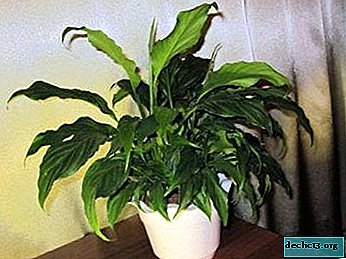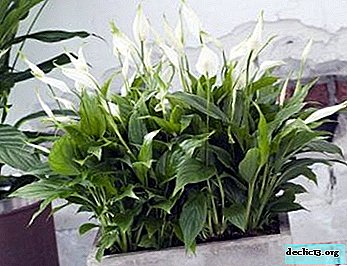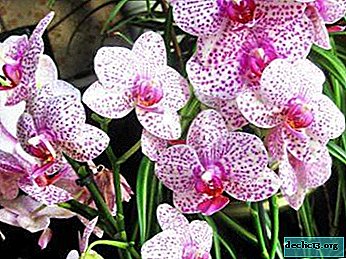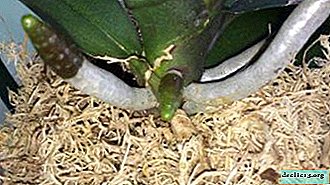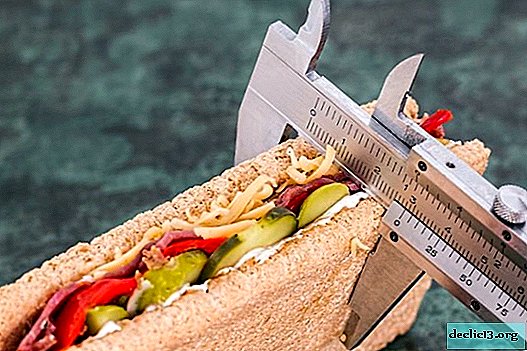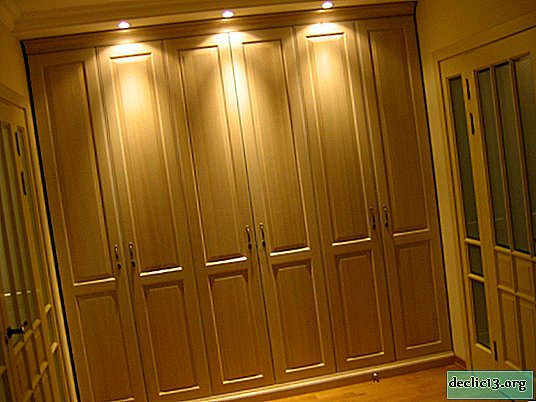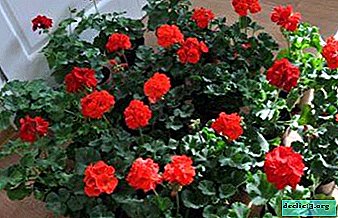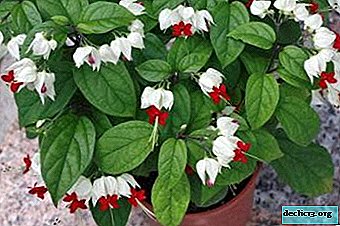Methods of propagation of tuberous begonia at home
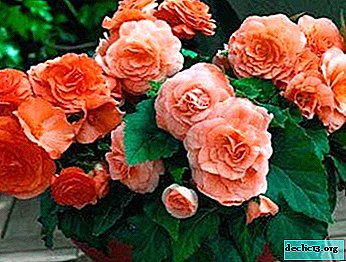
Begonia is a bright, elegant and amazing plant that will not leave anyone indifferent. Many beginner gardeners are wondering how demanding it is to care. The flower is really moody, because the environment suitable for it is the tropics and subtropics.
And in a temperate climate begonias are more difficult. But, as they say, nothing is impossible. You just need to familiarize yourself with the basic rules for care and reproduction, and begonia will grow in your house or near it no worse than in the tropical forests of South America.
What kind of flower is this?
There are a lot of species of begonia, but The tuberous variety is considered the most beloved by our summer residents and amateur gardeners. It is decorated with multicolored flowering flower beds of suburban areas, and pleases the eye from spring to late autumn. And in greenhouses or winter gardens, plants can bloom year-round.
Tuber begonia is a perennial shrub, hybrid type. The stalk is strong, fleshy. There are large-flowered varieties in diameter up to 25 cm, collected in inflorescences. They are placed on long peduncles. The color of the petals is diverse, depending on the variety. The texture of inflorescences is terry, semi-double and smooth. The kind of flowers resemble a little inflorescence of roses, peonies. The leaves have an asymmetric, heart-shaped shape. Their color is dark green with a glossy sheen, from below they are light green.
On a note. Especially attractive and elegant look ampelous varieties, with long branched shoots. They are used to decorate suspended and vertical street structures.How can a plant be propagated at home?
 This species reproduces well by any method:
This species reproduces well by any method:
- planting seeds;
- leaf or cuttings;
- dividing the tuber.
The seed method, as a rule, is the most troublesome, because it requires regular monitoring. However, a rather interesting way from the point of view of an unusual combination of maternal qualities. The second two methods are practiced when it is necessary to rejuvenate the plant, they are not so laborious, but they have their own specifics.
From seed
Growing begonias with the help of seeds gives some inconvenience, and also has a number of features. Begin planting seeds in late February, The deadline is mid-March, then at the beginning of summer the first flowers will appear. If planted later, the result will be small planting material, tubers of only 1-3 cm in size, and flowering will be only in a year.
Throughout the process of growing seedlings, seedlings need additional lighting, about 5 hours a day. It is best to sow freshly picked seeds, although their germination period lasts up to 3 years.
Seedling boxes are chosen as the capacity. It is better to buy the soil already ready, non-acidic. The bottom of the pot is covered with a mandatory drainage layer. A day before planting seeds, the earth needs to be watered. The temperature of the soil should be within + 26-27 ° C. Seeds are carefully planted in the ground, they are quite small. After cover with glass or other translucent material.
Seedling boxes are placed in a room with a temperature of + 22-24 ° C and additional lighting. Every day it is recommended to wipe the glass, remove condensate, ventilate the crops. The time of emergence of seedlings varies from 10 to 21 days. After the appearance of the first seedlings, the container is rearranged on a light windowsill, with a room temperature of + 15 ° C. This is done so that the seedlings are not stretched, but evenly developed and strengthened.
You can dive seedlings with 2-3 leaves. It is also important to feed the young shoots with mineral fertilizers and pinch as you grow.
Reference. If in the future it is planned to decorate street space with begonia, then for about a month the plant is subjected to hardening.By cuttings
Florists use the vegetative method twice a year, namely in spring and autumn. In winter, a dormant period begins for tuberous varieties, the entire terrestrial part of the plant can die, but do not forget about hydration. In the spring, a new shoot will go from the root. Read more about the propagation of tuberous begonia with cuttings in our article.
Tuber
 For spring cuttings, uterine tubers are needed, which rested in the fall for three months. In early January, the tubers get out of the wintering place. They are placed in a soil substrate and left in a warm place, with an air temperature of + 20-22 ° C. More information about how to save the plant in the winter can be found here.
For spring cuttings, uterine tubers are needed, which rested in the fall for three months. In early January, the tubers get out of the wintering place. They are placed in a soil substrate and left in a warm place, with an air temperature of + 20-22 ° C. More information about how to save the plant in the winter can be found here.
Periodically, the tubers are moistened so that they do not dry out, as well as for the appearance of new processes. After about 30 days, the young shoots break off. The slice is disinfected with crushed charcoal. After placed in a dry mixture of “Kornevin,” and then in a container with soil. The appearance of roots occurs somewhere after 20-30 days.
The stalk
In autumn, before digging a plant from the soil, the upper sections of the stem are healthy and strong, 8-10 cm long, as cuttings. They must have at least three buds. Leaves must be removed, leaving no more than two, so as not to take away the force from the sprout. Sections should be treated with drugs to stimulate root formation "Kornevin", "Zircon".
Next, the processes are placed in flowerpots with the ground. Planting depth 4-5 cm. Before the onset of heat, they are in a room with regular, plentiful watering.
Sprouting leaf
For propagation, you can also use a begonia leaf, which is put into water for germination. When root formation in water, it is recommended to choose containers made of transparent material, of small diameter. This is done so that the shoot not only grows, but also gains strength.
Attention! Water should be clean without impurities and salts. An activated carbon tablet should be added to the container with the handle, as a precaution against the development of fungal infections.For about 30 days, the sprout is placed in a bright place, with a temperature of + 22-24 ° C. Do not forget about humidity - at least 60%. Transparent material allows you to immediately see hatching roots. After a month, the root system will form.
However, beauties grown in a vegetative way by the fall do not have the tubers necessary for winter storage. Therefore, they are grown exclusively as annuals.
Tuber propagation
 At the end of autumn, green shoots die off from a street begonia. The dried part of the plant is cut off, and the balls are dug out of the ground. First of all, excess soil is removed from them, and then treated with a solution of potassium permanganate. The dried tubers will be placed in a box with sawdust, wet sand, peat or other natural substrate. Tubers are stored in a room with a temperature of + 7-9 ° C and a humidity of 80%. Basements, cellars, greenhouses are best suited for the storage process. The mixture in which the tubers are located is periodically moistened.
At the end of autumn, green shoots die off from a street begonia. The dried part of the plant is cut off, and the balls are dug out of the ground. First of all, excess soil is removed from them, and then treated with a solution of potassium permanganate. The dried tubers will be placed in a box with sawdust, wet sand, peat or other natural substrate. Tubers are stored in a room with a temperature of + 7-9 ° C and a humidity of 80%. Basements, cellars, greenhouses are best suited for the storage process. The mixture in which the tubers are located is periodically moistened.
In early spring, the tubers should be removed and left for a while in a warm room so that they warm up. Before planting on a flower bed, it is advisable to germinate in fertile soil. Tubers of large or medium size can be divided into several parts. The main thing is that each part contains at least two kidneys. Cut the sections with ash, put in a warm place and provide moderate watering. When spring night frosts are no longer terrible, tuber begonia is planted in open ground.
About how to plant begonias at home, read this article.
Possible problems and solutions
- A cut of the handle in the water began to rot. Perhaps the plant has contracted a fungal infection. It is necessary to remove the stalk from the water, cut off the rotten part, put in a container with fresh water, into which ½ tablets of activated carbon are added.
- The shoots begin to blacken. This may be due to fungal disease gray rot. It develops in a cool and humid room. To save young sprouts, it should be treated with fungicide, and also regularly ventilate and heat the room.
- Begonia seeds do not peck for a long time. Perhaps the reason for this is dry soil, or low room temperature. Measures should be taken: moisten the soil, and increase indoor temperatures to + 22-24 ° C.
- Seedlings stretch, becoming long and thin. Plants clearly lack sunlight. If possible, it is worth moving containers with seedlings closer to the light source.
- The leaves turn yellow and curl. Perhaps the plants lack moisture or the room is hot. In order to establish the growth process, one should revise the irrigation regime and lower the air temperature.
- Slow growth. Maybe a young plant does not have enough nutrients in the soil, so you should feed it with fertilizers.
You can learn more about the diseases and pests of tuberous begonia here.
Care after landing
On a note. Tropical beauty requires special conditions, she is often subject to stress, and the development process depends on the surrounding parameters.For good results when growing begonias It is worth paying attention to the following features:
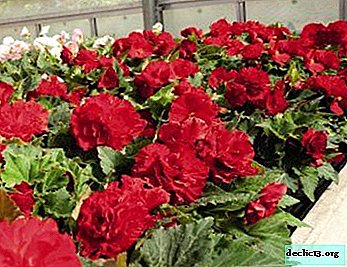 The optimum temperature and humidity regime in the room should be at the level of + 18-22 ° С, humidity 60%.
The optimum temperature and humidity regime in the room should be at the level of + 18-22 ° С, humidity 60%.- Prefers tuber begonia diffused sunlight.
- It is necessary to moisten the plant in the morning or in the evening with mostly warm water. Avoid bay. Watering is necessary again when the topsoil dries well. In no case do not spray the plant, otherwise it can lead to the development of fungal diseases.
- During flowering, it is important to feed the flower with fertilizers with a high content of potassium and phosphorus. In the phase of active growth, fertilize with nitrogen minerals, but in moderation.
- In winter, the air temperature should be maintained at a minimum of + 16 ° C, with minimal watering.
- If necessary, pick up dried flowers, loosen the soil, spray, remove dust from the leaves, inspect the plant for pests.
Based on the above materials, you can safely begin to engage in the cultivation of tuberous begonia. A little effort, time, in the end you get an attractive and beautiful plant.
Useful video
Propagation of tuberous begonias:

 The optimum temperature and humidity regime in the room should be at the level of + 18-22 ° С, humidity 60%.
The optimum temperature and humidity regime in the room should be at the level of + 18-22 ° С, humidity 60%.

